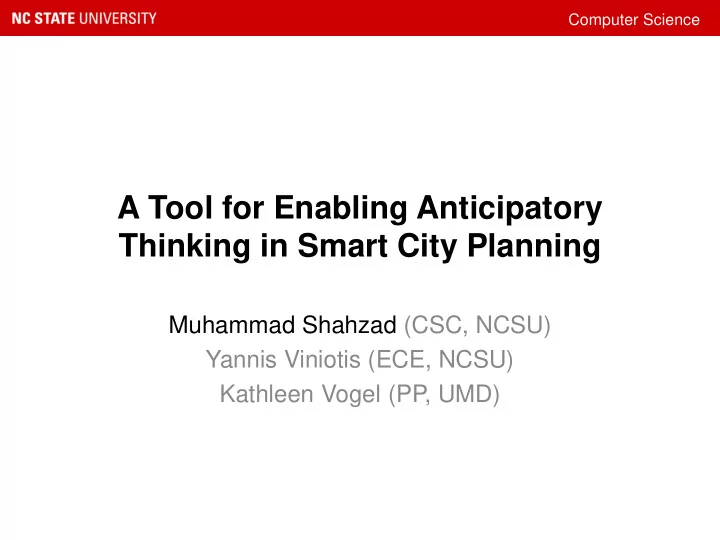

Computer Science A Tool for Enabling Anticipatory Thinking in Smart City Planning Muhammad Shahzad (CSC, NCSU) Yannis Viniotis (ECE, NCSU) Kathleen Vogel (PP, UMD)
Computer Science Agenda • Introduction of Anticipatory Thinking • Introduction of Futures Wheel • Anticipatory Thinking in Smart Cities • Objectives of Our Tool • Demo
Computer Science What is Anticipatory Thinking (AT) • Foreseeing and preparing for problems and opportunities in advance • Exploratory by nature – Identify consequences – Identify consequences of consequences – And so on… • Best done by domain experts – One can not anticipate what one does not know about – Knowledge and Experience: both are needed
Computer Science How is AT different from Prediction? • My view – Prediction of a consequence is done when the consequence is known apriori – AT is more open ended: consequences are explored, and not necessarily known apriori • Other views – AT is functional • Preparing for future, not simply predicting what might happen • AT also involves establishing connections between events – Appreciate and utilize their interdependencies
Computer Science Examples • Prediction – How will increase in temperature affect total power demand of a city? – The focus is on a specific quantity • Anticipatory Thinking – What consequences might the increase in temperature have on routine city operations? • Increase in power demand • Increase in water consumption • Reduction in outdoor activities – Change in traffic patterns » Congestion on roads • AT can help identify low probability - high impact events
Computer Science What is Futures Wheel • A visualization method to apply AT – It basically entails asking what else or what’s next – Helps brainstorm the direct and indirect consequences of an event, decision, change, or trend • Consequences can be positive, negative, or neutral – The organization it brings can help reduce uncertainty about the event, decision, change, or trend – A qualitative method • At least for now!
Computer Science How to Construct a Futures Wheel • Write the event, decision, change, or trend in the center
Computer Science How to Construct a Futures Wheel • Brainstorm possible direct consequences of this event • Positive as well as negative • These are "first-order" consequences • Write each consequence in a circle, and connect it from the central event
Computer Science
Computer Science How to Construct a Futures Wheel • Brainstorm possible direct consequences of the first- order consequences. • These are “second-order" consequences • Add them to the diagram in the same way • Repeat the process for third-order, fourth-order consequences and so on
Computer Science Source: https://www.mindtools.com/pa ges/article/futures-wheel.htm
Computer Science Example: Department Budget Cut Source: https://www.mindtools.com/pa ges/article/futures-wheel.htm
Computer Science Example: Flint Water Crisis
Computer Science Benefits of Futures Wheel • A broad range of possible consequences identified quickly • Consequences are connected, so one can see their pathways • One can study complex interrelationships between consequences
Computer Science A TOOL TO FACILITATE ANTICIPATORY THINKING FOR SMART CITY PLANNING
Computer Science The Need for AT in Smart Cities • As cities grow, various services that the city offers can interact and impact each other in numerous ways • Anticipatory thinking can enable to identify such interactions and impacts • AT can also help in identifying the best method to achieve a goal
Computer Science City Planners Already using AT… Implicitly! • Indirect Statements in Policies (many) – Policy AP-FON 1: Falls of Neuse Corridor Character. Protect the character of the corridor. Maintain the sense of place created by the extensive roadside vegetation, the Falls Lake dam, and Falls Community.
Computer Science Collaboration with City Planners & Smart City Technology Designers • We plan to interview 10-30 professionals who are either city planners or smart city technology designers in order to better understand their: – work and its constraints – thoughts about so-called “smart cities” – ideas about the tools future city planners will need – perceptions of policy changes that will need accompany smart technologies – reactions to a proposed “anticipatory thinking” software designed to assist them in their work • From these interviews, we will derive a robust description of their activities, the constraints they operate within, and their perceived technological needs. • By relaying this information to the engineers/designers, we will better ensure that the software produced is of use to city planners -- furthermore, our research may allow us to uncover technical needs that are not being addressed, but could be addressed (by future LAS projects).
Computer Science Current Objectives of Our Tool • Using the Futures Wheel concept – Visual • Enable exploration of consequences of any given event/action • Help identify good paths from bad paths – Analytical • Calculate likelihoods of occurrences of various consequences – Conventional Futures wheel was qualitative • Provide hints to smart city planners in identifying consequences – Hard coded – Basic text analysis based
Computer Science Future Objectives of Our Tool • Gather the wisdom of many city planners over the years and use it to benefit future smart city planning. – Recall the Knowledge and Experience discussion • Automatically identify similar consequences in the wheel • Automatically generate a preliminary Futures Wheel • Automatically generate the Futures Wheel for any given situation
Computer Science A DEMO
Recommend
More recommend